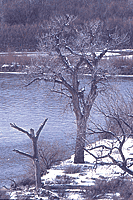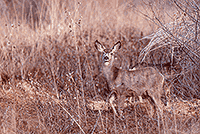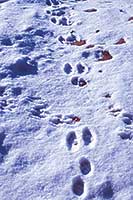Defining January |
|
 January in Canyon Country represents the heart of winter, but also signals that spring is not far off. Named after the Roman god Janus, often depicted with two faces – one looking forward, one looking backwards – he stood at the gate of the New Year, reflecting upon the past and peering into the future. January in Canyon Country represents the heart of winter, but also signals that spring is not far off. Named after the Roman god Janus, often depicted with two faces – one looking forward, one looking backwards – he stood at the gate of the New Year, reflecting upon the past and peering into the future.Back when Janus was kicking around, the New Year began on Winter Solstice. Changes in organization and standardization eventually reformed this Roman calendar into the Julian calendar, named after Julius Cesar, which then transformed to the modern day Gregorian calendar by which most of us operate. Temporal considerations aside, I have my own associations for this period that coincides more with wildlife and the stillness that cloaks the landscape. For me, January always meant time to go to the Cisco. I would travel north from Moab into the Cisco Desert, a vast area of openness and undulating terrain, to look for wintering birds of prey and other wildlife. Cold temperatures would congeal the mud making travel on the dirt roads in the area passable. Golden eagles, bald eagles, red-tailed hawks and the Arctic breeding rough-legged hawk spend time in this area pursuing prey and winterkill. The rough-legged, named for their feathered legs, perch on power poles or dirt mounds, their dark carpal patches a good field mark as the birds take to flight.  Occasionally, I would run into a predator free-for-all, with coyotes, bald and golden eagles fighting over some carcass or trying to pirate prey from the successful hunter. The melee resembled a rugby match as one of the participants would bolt from the scrum with the spoils, only to be harassed by the others. Occasionally, I would run into a predator free-for-all, with coyotes, bald and golden eagles fighting over some carcass or trying to pirate prey from the successful hunter. The melee resembled a rugby match as one of the participants would bolt from the scrum with the spoils, only to be harassed by the others. Standing a safe distance away, a large spectator herd of pronghorns would watch the chaos. Alert and ready to bolt, these animals could easily use their speed in the open country to distance themselves from danger. Relying upon each other to signal a warning, these speedsters join up in winter herds searching for open ground and snow-free forage.  If the Cisco was too quiet or the roads impassible, I’d venture down to the Cisco landing on the Colorado River. I could usually count on seeing bald eagles perched in the large cottonwoods that lined the river or watch rafts of waterfowl avoiding ice chunks bobbing in the river. Canada geese, common goldeneyes, gadwalls, buffleheads and mergansers might be dabbling for vegetation or diving after minnows and aquatic invertebrates. If the Cisco was too quiet or the roads impassible, I’d venture down to the Cisco landing on the Colorado River. I could usually count on seeing bald eagles perched in the large cottonwoods that lined the river or watch rafts of waterfowl avoiding ice chunks bobbing in the river. Canada geese, common goldeneyes, gadwalls, buffleheads and mergansers might be dabbling for vegetation or diving after minnows and aquatic invertebrates.As I would scan the shorelines and river bottoms, I’d often observe mule deer or the occasional elk foraging on the grasses and shrubs. Deep winter snows at higher elevations would force these animals down into the lowlands, but the silence of winter probably contributed to their safety level here. I would quietly observe their activities and feel enhanced by their presence. The sparseness of the Cisco Desert landscape with its scattered shrubs, short grasslands and gently folded clay-rich soils often deters people from exploring this area. Lacking spectacular redrock formations, the grayish Mancos Shale and Dakota Sandstone formations that dominate the area won’t find themselves gracing the cover of any glossy brochure. This area is best left to the cottontails and prairie dogs, squabbling birds of prey and wandering pronghorn. But for me, the area represented an opportunity to have my Janus-moment: to let the desert silence trigger my retrospective look back across the year and to use the present to springboard me towards the approach of spring.
|
